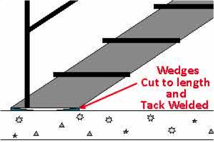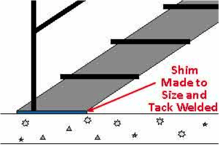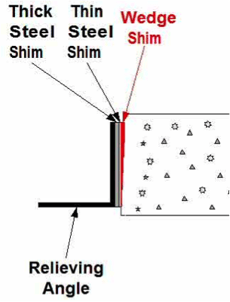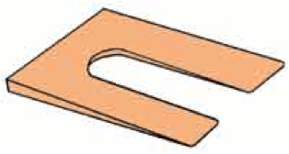The Slotted Steel Shim and the Steel Wedge have some separate and some overlapping functions. The wedge has the ability to multiply force for lifting purposes. (To read more about the lifting force of the steel wedge, click here.
The Slotted Steel Shim does not share this capacity. Where the Wedge and the Shim overlap is in spacing. The wedge provides any thickness desirable, theoretically to the .001”, but only one contact point. The shim is constrained to an exact thickness but can make contact with as much surface area as desired.


In the drawings shown above a shim or two wedges are used to secure a staircase where one stringer does not sit solidly on the ground. Even though the wedge makes little contact with the steel stringer the low stress involved makes either solution perfectly viable. Typically decisions such as these are made purely by time and cost benefit.

In the drawing to the left a relieving angle is mounted to a concrete floor slab using a series of shims. Most relieving angle jobs require some stand-off between the angle and the concrete to allow for moisture and atmosphere to circulate out. The thick steel shim should accomplish this. The thin steel shims is used to compensate for any deviation inward or outward along the length of the slab. In the case of Relieving Angles Galvanized Steel Shims are usually required.
Note: The askew head bolt or threaded embed, washer and nut have all been omitted from the drawing for simplicity.
In the drawing the edge of the concrete slab is angled inward. The Wedge Shim, shown in red, compensates for deflection from top to bottom. Often the concrete forms were not straight to begin with, or flexed during the pour or curing time, leaving the edge of the slab not perpendicular. To correct this a number of methods can be used, but the most desirable is one that provides full surface contact. A slotted wedge shim will provide both full surface contact and the necessary spacing to let the relieving angle be upright.
Standard slotted steel shims are usually flat. Slotted Steel Wedge Shims can be made to order however the extra manufacturing processes cause them to be expensive. A much less costly alternative is the Construction Grade Plastic Slotted Wedge Shim. Dimensions are 3” wide x 4” long and in compression tests it withstands an impressive 100,000 lbs. psi. The use of Plastic Slotted Shims should be authorized by the project engineer.
manufacturing processes cause them to be expensive. A much less costly alternative is the Construction Grade Plastic Slotted Wedge Shim. Dimensions are 3” wide x 4” long and in compression tests it withstands an impressive 100,000 lbs. psi. The use of Plastic Slotted Shims should be authorized by the project engineer.
Click here for Plastic Slotted Wedge Shim





